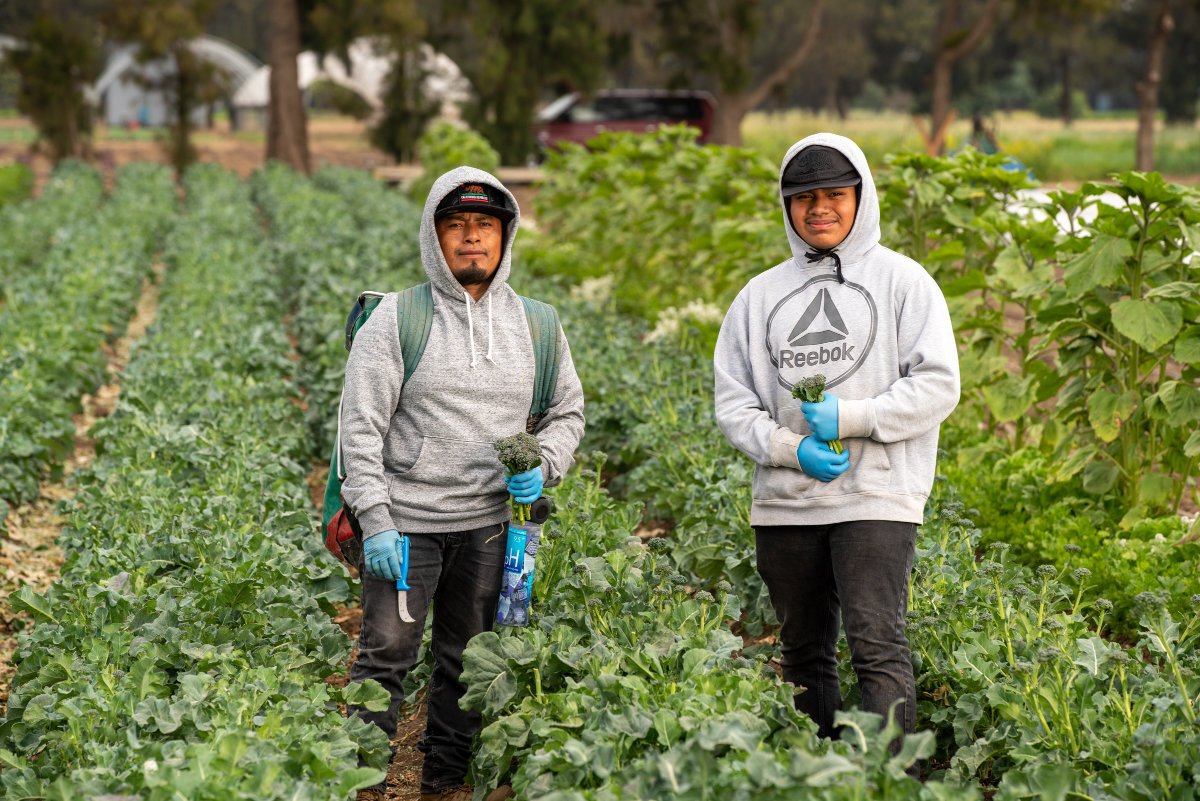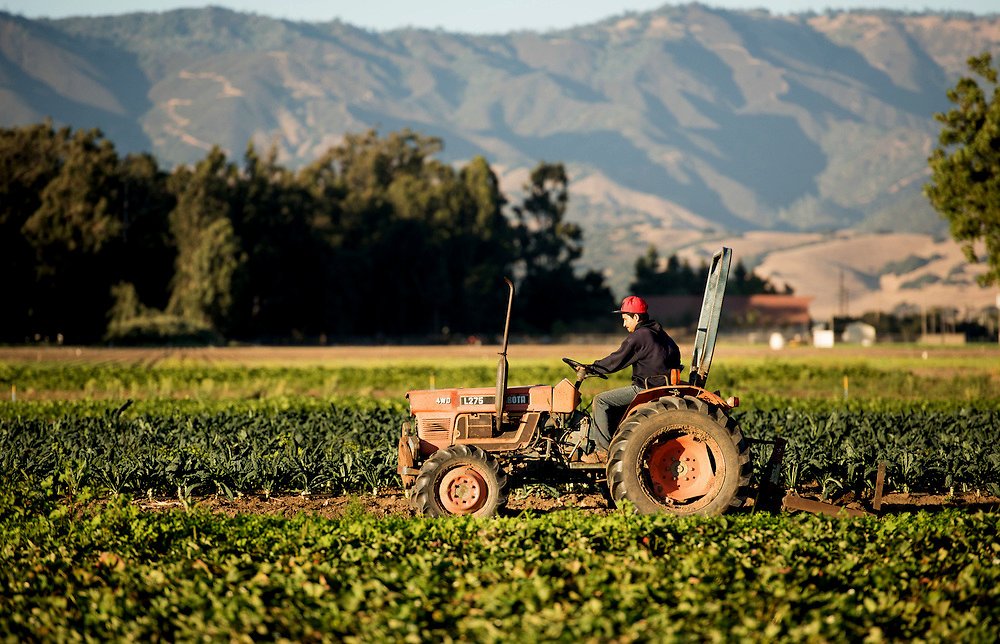California’s farmworkers face untold barriers accessing the land, capital, and training needed to strike out on their own. For 20 years, ALBA has been slowly changing the landscape for this important group of aspiring growers.

California’s farmworkers face untold barriers accessing the land, capital, and training needed to strike out on their own. For 20 years, ALBA has been slowly changing the landscape for this important group of aspiring growers.
January 18, 2024

One of ALBA’s partners, a father-son duo. (Photo courtesy of ALBA)
Herlinda Huipe and her husband Carmelo Rojas operate Tierra HR Organic Farm on California’s Central Coast. It’s small, so they both still work part time on larger farms, primarily picking strawberries.
But the couple has recently hit a milestone: During their busiest harvest days, they’ve had to hire people to help with their celery crop.
“They are people who are really fast at cutting it,” Rojas said, “and we pay them as contractors.”
The catalyst that led Huipe and Rojas to segue from farmworkers to farm owners is the Agriculture and Land-Based Training Association (ALBA) in Salinas, California, which for more than two decades has offered classes, on-farm training, land, equipment, and business support to aspiring organic vegetable farmers. ALBA has received over $15 million in support from federal grants, local and national foundations, and individual donors in the last 20 years, and more than 220 businesses have launched with the organization’s support since 2001.
In an impact report published last fall, ALBA development director Chris Brown found that more than 10 new farms get started each year and four to six expand beyond ALBA’s land.
Brown also learned that among the 121 alumni farmers who responded to a survey, 77 are still operating a farm business. Meanwhile, others are working in farm-support roles, as intermediaries between farm owners and product buyers and as administrators or business support staff for other farms.
Recently, Brown said, he spoke with one alum who told him “she is helping farmers with marketing because, she said, ‘she’s not as good of a grower.’”
ALBA welcomes anyone, Brown said, but in this region known for growing heavily labor-dependent strawberries and leafy greens, the organization’s focus and greatest impact has been with immigrant farmworkers, mostly from Mexico and Central America. “They want to get away from that lifestyle and farm on their own,” he said.
Huipe and Rojas had the dream but until a friend told them about ALBA, they had no idea how they would even begin the transition. “We are really so grateful to ALBA, and all the people there.” Rojas said recently in Spanish. “They are friendly and always help us.”

One of ALBA’s farmer partners driving a tractor. (Photo credit: Shawn Linehan Photography, courtesy of ALBA)
The impact report also noted that many immigrants enter the program with lots of field experience and sometimes even years operating their own farms before coming to the U.S. But Brown said there are also U.S.-born participants, many of them children of farmworkers, who “tend to enroll in the program at a younger age.”
That’s important because while it’s great to see middle-aged farmworkers create their own businesses, attracting younger people to agricultural careers is especially important, as the average age of the American farmer hovers around 60, and the high cost of land and other capital has kept many young people out of the industry in recent years. And historically, in addition to land, people of color have had a hard time accessing federally funded supports that many long-time farm families have come to expect.
In a 2020 report, the California Department of Food and Agriculture (CDFA) noted that about 23,600 of the 124,400 farmers and ranchers in the state were considered “socially disadvantaged,” meaning they were women and/or people of color. These producers often face language barriers, challenges securing long-term land access, and a lack of engagement with resources from CDFA. ALBA’s goal is to address all of these hurdles.
The ALBA program begins with introductory course work, which Huipe and Rojas completed in 2021. Then, they were invited to farm half an acre of land owned by the organization. The deal also came with equipment they could use, technical assistance from ALBA’s farm manager, and a nearly guaranteed market for their crops through Coke Farm, a local food hub and distributor that works with 70 organic producers. Now, the couple are in the process of expanding to 5 acres.
Land access can be the biggest barrier to getting started in farming—for everyone, but especially for young people, BIPOC farmers, and immigrants. In the growing national conversation about land justice, ALBA stands out.
Jennifer Hashley, director of the New Entry Sustainable Farming Project in Massachusetts, said her group and ALBA were among a handful across the country that have created a framework for “how to help folks get into the business of farming and how to be successful. How to overcome all the intense barriers of access to land, capital markets, fair prices, labor issues.”
As a result, she said newer farm incubator programs have turned to ALBA as an example.
“They really did develop a comprehensive production and training program that sets the bar,” said Hashley. The fact that it combines education—the year-long course called PEPA after the Spanish acronym for Programa Educativo Para Pequeños Agricultores, or Education Program for Small Farmers—with land access and farm supports is one key element of what sets it apart from other programs.
Brown said most farmers who complete the ALBA program are prepared to be on their own.
“By that time, their mettle has been tested. They’re showing potential,” he said. “They’re starting to understand and starting to master the various responsibilities of being a farm owner.”
And he said in the Salinas Valley, he’s beginning to see ALBA alumni working with landowners in creative ways.
“Farmers are finding larger pieces of land that are available for rent and they’re subleasing them,” he said. A landowner might have 100 acres available, which is too much for one new farmer. But together a handful of ALBA alumni can divide up the land for their individual farms. “Landlords are getting more comfortable with that idea,” Brown said.
The work is gradually impacting the number of organic acres and the demographics of farm operators in California and could continue to do so in the future.
CDFA estimates that statewide about 10 percent of California farm acres were operated by people of color in 2020. But that’s according to the 2017 Census of Agriculture, and data from the 2022 census should be forthcoming this year.
Farmers learn to use organic practices at ALBA and the vast majority, Brown said, continue to use them once they’re on their own. That has the added bonus of growing more food with less dependence on fossil fuel-heavy practices, like synthetic fertilizer. The total acres may be small, but using cover crops and rotating what’s grown each year can have climate benefits such as improving soil health, reducing erosion, and preventing toxic runoff.
“A lot of [farmers] said they were completely surprised that they could even do this,” Brown said, referring to running a farm. But these experienced, ambitious, hardworking people are filling a gap in U.S. agriculture as large farms continue to consolidate and long-time farm families see their children move away.
“No one’s being realistic about who’s going to farm,” Brown said. “It’s right in front of us, though: farmworkers—83 percent are Latino, there’s like 2 million of them. Probably 2 million, 3 million more in the back of restaurants, on packing lines, cleaning hotels, or whatever. They have that farming experience. They’re connected with it.”
ALBA has positioned itself to give this demographic the lift they need to get started.
“They have the grit and they have the desire,” he said, “and that’s very, very rare in our population today.”
The report found that farms nearly triple in acreage (on average) after leaving ALBA, and most are exclusively growing organic produce. While the independent farms typically rely on Coke Farm for distribution, 18 percent of the farmers reported growing more than 20 different crops, indicating that they are also making “sales through farmers markets or direct sales channels that demand more crop diversity,” the report reads.
Brown said he’s especially pleased that some alumni farms are also now selling produce directly to area schools. ALBA has also built a network of partner organizations that helps the new farms succeed on their own. Ernesto Soto, grower liaison-manager at Coke Farm, said the relationship goes both ways.
“We’re building an ecosystem, right?” Soto said of family-run, organic farms along California’s Central Coast. Coke gets the produce to retailers such as Whole Foods, a market that would be almost impossible for a beginning farmer to crack. “We’re their infrastructure” for things like cooling, packing, and marketing, Soto added. They also help build relationships with buyers.
Brown said the network of supports also includes groups more focused on running the business, such as Kitchen Table Advisors and California Farm Link, which may ultimately help new farms secure loans and navigate the business development piece of running a farm.
After conducting the survey of alumni, analyzing the data, and compiling the impact report, Brown said the conclusion he draws is that ALBA remains open to changing in necessary ways to best serve aspiring farmers. For example, it has joined the Blue Zone Project, a Salinas Valley Health initiative. He said it’s also introduced area nutrition directors to the feasibility of sourcing local, organic produce from small farms.
“We’re a work in progress, still,” he said, “even after all these years.”

September 4, 2024
By paying top dollar for milk and sourcing within 15 miles of its creamery, Jasper Hill supports an entire community.
September 3, 2024

August 27, 2024

August 26, 2024

Like the story?
Join the conversation.